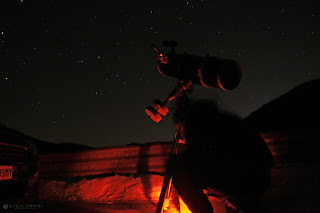Last Saturday I went with astrocampania on the Mounth Terminio for evening oberving that hosts monthly.
Astrocampania's are a great groups of amateur astonomers, I learn many things from them, are especially astrophotografers, but I with my Skywatcher 130/900,I must be content to do only comments yet.
From dobson Mirko, I could see and observe for a long time the open clusters M36,M37, M38, found all three in the costellation of Auriga.
The double clusters of Perseus, and of course her,which dominates the winter sky : the legendary Orion Nebula M42.
Planetary nebulae are the product of the last stages of the life of a star'smedium to large.
When it reaches the end of its life,it ejects its outer layers in various episodes of nuclear fusion reactions.
While the parent star shrinks it, which spreads with great speed and this could to be called a planetary nebulae.
Then I went from a guy who was photographing the nebua in a unicorno costellation, and I got a podium to explain astrophotograpy. Well the first thing to do is to get a decent frame and then the rest.
I put some photos of evening...sky clear at all.
Versione italiana.
Sabato scorso sono andata con glia strocampania a Monte Terminio per la serata osservativa che fanno ogni mese.Astrocampania è un grande gruppo di astrofili, io imparo molto con loro e sono soprattutto astrofografi, ma io con il mio telescopio skywatcher 130/900, devo accontentarmi ancora di fare solo osservazioni.
Dal dobson di Mirko io ho potuto osservare anche per lungo tempo, tre ammassi che si trovano nella costellazione dell'Auriga: M36,M37,M38.
Il doppio ammasso di Perseo e lei, che domina il cielo invernale: la famosa nebulosa di Orioneo M42.
Le nebulose planetarie sono il risultato dell'ultima fase di vita di una stella di massa medio-grande.
Quando raggiunge la fine della propria vita, essa espelle i propri strati esterni in vari episodi di reazioni di fusione nucleare. Mentre las tella geenritrice diventa una nana bianca, il gas eiettato forma una nube di materia attorno ad essa che si espande con grande velocità. è questa nube ad essere chiamata nebulosa planetaria.
Poi andai da un ragazzo che stava fotografando una nebulosa nella costellazione dell'unicorno, e gli chiesi qualche nozione dia strofotografia..beh..la prima cosa che mi serve è quella di procurarmi almeno una montatura decente..poi verrà tutto il resto.
Cieli sereni a tutti.









Nessun commento:
Posta un commento